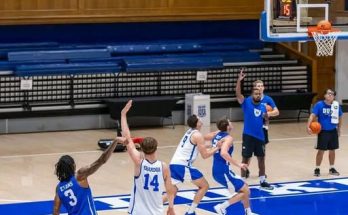As college football fans eagerly look ahead to the 2025 season, ESPN has once again released its annual Returning Production metric, a key analytic that provides insight into which programs are best positioned for success based on how much of their previous season’s production is coming back. For LSU, a team that enters the year with high expectations and a roster full of both proven talent and new faces, its ranking in this metric has turned heads — not for being near the top, but because it falls much lower than fans might have hoped. The Tigers rank No. 85 nationally in ESPN’s 2025 Returning Production metric, a number that may surprise even the most plugged-in followers of the program.
ESPN’s Returning Production metric, devised by Bill Connelly, breaks down the percentage of production a team retains from the previous year. It factors in statistics from both offense and defense, such as passing yards, rushing attempts, tackles, passes defended, and more. The goal is to determine continuity and potential readiness for the coming season. For LSU to rank in the bottom third of FBS programs is both a reflection of significant roster turnover and a potential warning sign about early-season growing pains.
So why exactly is LSU so low on this list? A closer examination of the Tigers’ offseason provides some clarity. Offensively, LSU is facing a complete reset at the quarterback position. Jayden Daniels, the 2023 Heisman Trophy winner, is now headed to the NFL. With Daniels gone, along with several key offensive contributors including wide receivers Malik Nabers and Brian Thomas Jr., and offensive linemen Charles Turner and Miles Frazier, it’s no wonder LSU’s offensive returning production has taken a hit. That production void is particularly important because Daniels was responsible for a massive chunk of the team’s yardage and scoring.
At wide receiver, losing both Nabers and Thomas removes more than 2,500 receiving yards and 31 touchdowns from the equation. While LSU has a history of reloading with elite talent at the position — and promising young stars like Kyren Lacy and Shelton Sampson Jr. could step up — there’s a clear gap in returning experience and chemistry. The same applies to the backfield, where Logan Diggs provides some continuity but is returning from injury, and the offensive line will feature new faces in key roles.
Defensively, the story is similarly complicated. LSU’s defense was heavily criticized throughout the 2024 season, but it still loses a significant amount of experience heading into 2025. The Tigers saw a number of veterans, including linebacker Greg Penn III and defensive backs Major Burns and Sage Ryan, leave the program either for the NFL or through the transfer portal. Defensive line stalwart Mekhi Wingo is also gone, leaving LSU with both production and leadership holes to fill.
Despite the low ranking, however, there are reasons to believe LSU may outperform this metric. For starters, the Tigers have recruited at an elite level under head coach Brian Kelly. The 2024 and 2025 recruiting classes have both been loaded with top-tier talent, and many of those young players are now ready to step into larger roles. Players like Harold Perkins Jr. return as potential game-changers, even if their individual production from last year doesn’t dramatically move the needle in ESPN’s formula.
Perkins, in particular, remains one of the most electrifying defenders in the country. His versatility and explosiveness give LSU a weapon few other teams possess. Similarly, cornerback Javien Toviano, now a sophomore, is expected to emerge as a shutdown option after flashing potential late in the season. On the offensive side, transfer quarterback Garrett Nussmeier appears poised to lead the unit. While unproven in extended action, his skill set and familiarity with the playbook offer optimism.
The metric also doesn’t fully account for development and scheme changes. LSU made a splash this offseason by hiring Blake Baker as defensive coordinator, returning him to Baton Rouge after a successful stint with Missouri. Baker is known for aggressive schemes that get the most out of his linebackers and defensive backs. If he can unlock LSU’s young defensive talent, the group could look very different from last year’s unit that struggled mightily, especially against the pass.
On offense, LSU will likely shift schematically to fit Nussmeier’s strengths. Daniels was a mobile quarterback who excelled when improvising, while Nussmeier is more of a traditional pocket passer with a strong arm and quick release. The offensive philosophy will evolve accordingly, and while that transition may cause some early hiccups, it could lead to a more balanced attack by midseason.
Another factor to consider is LSU’s track record of developing stars. Time and again, the Tigers have produced elite-level talent that broke out after biding their time behind veterans. Whether it’s a breakout from a sophomore receiver, a redshirt freshman linebacker, or a new face in the secondary, LSU has the depth and pedigree to overcome a lack of returning production.
Additionally, LSU benefits from playing in the SEC, where competition is fierce but the opportunities for quality wins are plentiful. The Tigers have a challenging but manageable schedule that includes key games against Alabama, Texas A\&M, Ole Miss, and Florida. If LSU can start fast and build momentum, it could quickly climb the rankings and defy preseason projections.
Still, the No. 85 ranking is a signal that this team will need to gel quickly. Early-season contests could be telling. LSU opens the year against USC in Las Vegas — a marquee game that will pit two new-look teams against each other in what could be a shootout. If the Tigers can come out of that matchup with a win or even a competitive showing, it will go a long way in silencing doubts raised by the returning production numbers.
Ultimately, ESPN’s Returning Production metric should be viewed as a starting point, not a crystal ball. It offers valuable insight into how much continuity a team retains, but it doesn’t fully account for the quality of that production, the context in which it was gained, or the potential impact of newcomers. For LSU, the low ranking reflects significant changes, but it doesn’t doom the season by any means. If anything, it may serve as fuel for a program with championship ambitions.
Brian Kelly has consistently emphasized development and culture since arriving in Baton Rouge. That mindset will be tested in 2025 more than ever. With so many fresh faces on both sides of the ball, LSU’s ability to coach up talent, build chemistry, and adapt will determine whether it exceeds expectations. The No. 85 ranking may raise eyebrows today, but it could look foolish by season’s end if the Tigers come together quickly and harness their potential.
In a sport increasingly defined by turnover, especially in the transfer portal era, raw returning production matters — but so does how you replace it. LSU has questions to answer, no doubt. But they also have the talent, leadership, and institutional confidence to turn those question marks into exclamation points. For now, the Tigers find themselves flying under the radar. Whether that proves to be a miscalculation or a warning sign will be one of the more compelling stories of the 2025 college football season.



